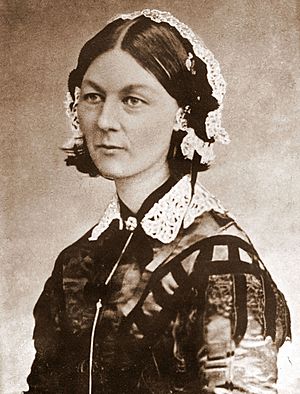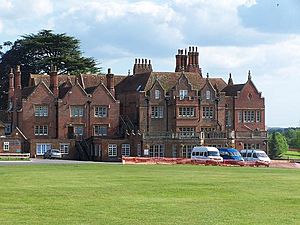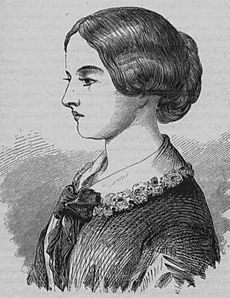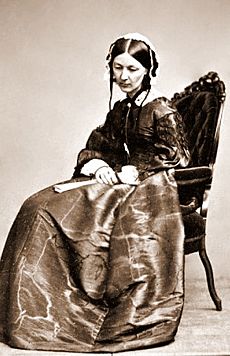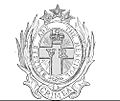Florence Nightingale facts for kids
Florence Nightingale, OM (12 May 1820 – 13 August 1910), was an English nurse. She helped create the modern techniques of nursing. She became a leader of the team of nurses who helped wounded soldiers during the Crimean War.
Contents
Early years
Florence Nightingale was born into an upper class British family in 1820 in Florence, Tuscany, Italy. She was named after the town where she was born. The family moved back to London when Florence was a young girl. She was a Unitarian. Although her parents expected her to become a wife and a mother, in 1845 she decided to become a nurse. While she was training she campaigned for better conditions for poor people in Britain.
Nightingale's father educated her. Florence and her older sister Parthenope studied history, mathematics, Italian, classical literature, and philosophy. From an early age Florence, who was the more academic of the two girls, showed an extraordinary ability for collecting and analysing data which she would use to great effect in later life.
Despite the anger and distress of her mother and sister, Nightingale rejected the expected role for a woman of her status to become a wife and mother. She worked hard to educate herself in the art and science of nursing, in the face of opposition from her family.
In 1850, she visited the Lutheran religious community at Kaiserswerth-am-Rhein in Germany, where she observed Pastor Theodor Fliedner and the deaconesses working for the sick and the deprived. She regarded the experience as a turning point in her life. She also received four months of medical training.
On 22 August 1853, Nightingale took the post of superintendent at the Institute for the Care of Sick Gentlewomen in Upper Harley Street, London, a position she held until October 1854. Her father had given her an annual income of £500 (roughly £40,000/US$65,000 in present terms), which allowed her to live comfortably and to pursue her career.
The Crimean War
In 1854 to 1856, during the Crimean War, Florence was working in Harley Street in London. After reading many reports about the poor treatment of sick and injured soldiers, she travelled to Crimea to see for herself and discovered the hospitals were crowded and dirty.
She knew Sidney Herbert, who was Secretary of War during the Crimean War and he helped her. At the hospital in Istanbul where the injured soldiers were sent, Florence realized that soldiers died more often from diseases like cholera than from their injuries in war. She used her knowledge of maths and statistics to show the British government that providing better conditions for sick and injured soldiers would help them win the war. She was, however, quite wrong about how cholera spread.
While she was working in Crimea she became known as “The Lady with the Lamp” from a phrase in a report in The Times because she would walk around the hospital in the evening carrying a lamp and check on the soldiers:
She is a "ministering angel" without any exaggeration in these hospitals, and as her slender form glides quietly along each corridor, every poor fellow's face softens with gratitude at the sight of her. When all the medical officers have retired for the night and silence and darkness have settled down upon those miles of prostrate sick, she may be observed alone, with a little lamp in her hand, making her solitary rounds.
The phrase was further popularised by Henry Wadsworth Longfellow's 1857 poem "Santa Filomena":
Lo! in that house of misery
A lady with a lamp I see
Pass through the glimmering gloom,
And flit from room to room.
School for nurses
When she returned to England she started a school in 1860 for nurses at St. Thomas’ Hospital in London. The first trained Nightingale nurses began work on 16 May 1865 at the Liverpool Workhouse Infirmary. Now called the Florence Nightingale Faculty of Nursing and Midwifery, the school is part of King's College London.
Works
In her lifetime she was concerned with spreading medical knowledge. Some of her books were written in simple English so that they could easily be understood by those with poor reading skills. In 1851, she issued The Institution of Kaiserswerth on the Rhine, for the Practical Training of Deaconesses, etc., her first published work.
She wrote her most important book Notes on Nursing (1859). The book served as the cornerstone of the curriculum at the Nightingale School and other nursing schools, though it was written specifically for the education of those nursing at home. Notes on Nursing also sold well to the general reading public and is considered a classic introduction to nursing. Nightingale spent the rest of her life promoting and organising the nursing profession.
She also was an early user of graphs and diagrams to display data.
Studies of statistics and sanitations
Nightingale was helped to understand statistics by her country's leading expert on public statistics, William Farr. He was a founder of medical statistics, and epidemiology. Farr worked with her on all the statistics from the Crimean War, which she publicised in her writing. She proved that more men had died from disease than fighting, a very important piece of information. The disease in question was mostly cholera. Cholera is caused by a bacterium spread by people drinking water contaminated by sewage. Unfortunately, both she and Farr believed the disease was caused by foul air: this was called the miasma theory.
The miasma theory was refuted by John Snow, who discovered the real cause of an outbreak in London. The cause was foul water from a water pump in Broad Street, London. Snow's work was published in 1855, but it was 30 years before the germ theory was generally accepted. Farr publicly acknowledged he was wrong in 1866, but Nightingale never really gave up the miasma idea. London's cholera epidemics stopped once the authorities built sewage treatment plants, delivered cleaner water, and built a system of underground pipes that kept sewage from seeping into the water supply.
She was concerned by the health of the British Army in India. Bad drainage, contaminated water, overcrowding, and poor ventilation were causing the high death rate among soldiers. Nightingale campained to improve the sanitary conditions not only in the army, but in the country as a whole. "After 10 years of sanitary reform, in 1873, Nightingale reported that mortality among the soldiers in India had declined from 69 to 18 per 1,000".
Death
Florence Nightingale died in her room peace fully in her sleep from heart attack in 1910 in London. She is buried in the churchyard of St Margaret's Church in East Wellow, Hampshire, near Embley Park with a memorial with just her initials and dates of birth and death. A memorial monument to Nightingale was created in Carrara marble by Francis William Sargant in 1913 and placed in the cloister of the Basilica of Santa Croce, in Florence, Italy.
Personality
Florence Nightingale was a wonderful woman who fought the odds of not living a life expected by her family. Florence Nightingale came from a wealthy family, but she refused the aristocrat lifestyle her family expected from her and instead focused on helping the poor, the injured, and the sick.
As a young woman, Nightingale was described as attractive, slender, and graceful. She was said to be very charming and to possess a radiant smile. Her most persistent suitor was the politician and poet Richard Monckton Milnes, but after a nine-year courtship, she rejected him, convinced that marriage would interfere with her ability to follow her calling to nursing. Nightingale also much later had strong relations with academic Benjamin Jowett, who may have wanted to marry her.
She was a keen Christian but also believed that pagan and eastern religions also contained genuine worth. She was a strong opponent of discrimination against all types of Christians as well as against non-Christians. Nightingale believed religion helped provide people with the fortitude for arduous good work.
Friendships
Mary Clarke
In 1838, her father took the family on a tour in Europe where she was introduced to the English-born Parisian hostess Mary Clarke. Florence generally rejected female company and spent her time with male intellectuals. Clarke made an exception. She and Florence were to remain close friends for 40 years despite their 27-year age difference. Clarke demonstrated that women could be equals to men.
Sidney Herbert
In Rome in 1847, she met Sidney Herbert, a politician who had been Secretary at War (1845–1846). He and Nightingale became lifelong close friends.
Herbert became Secretary of War again during the Crimean War. He and his wife were instrumental in facilitating Nightingale's nursing work in Crimea. She became Herbert's key adviser throughout his political career.
Interesting facts about Florence Nightingale

- In 1907, Florence Nightingale became the first woman to be awarded the Order of Merit, one of the highest honours awarded by the British monarch, by King Edward VII.
- In 1883, Nightingale became the first recipient of the Royal Red Cross.
- In 1904, she was appointed a Lady of Grace of the Order of St John (LGStJ).
- As a nurse she was given the name 'The Lady with the Lamp' because at night, she checked on the wounded soldiers and always carried 'The Lamp' with her.
- She helped make modern nursing possible.
- As a youth, Nightingale traveled to Greece and Egypt.
- While in Athens, Greece, Nightingale rescued a little owl from a group of children who were tormenting it, and she named the owl Athena. Nightingale often carried the owl in her pocket, until the pet died (soon before Nightingale left for Crimea).
- Nightingale was a prodigious and versatile writer, and lived to be 90 years old.
- There is a syndrome named after her called "Florence Nightingale Syndrome". It occurs when a soldier falls in love with a nurse.
- There are many statues of her in Britain, including one in Waterloo Place in London and a Florence Nightingale museum, also in London.
- Four hospitals in Istanbul are named after Nightingale: Florence Nightingale Hospital in Şişli (the biggest private hospital in Turkey), Metropolitan Florence Nightingale Hospital in Gayrettepe, European Florence Nightingale Hospital in Mecidiyeköy, and Kızıltoprak Florence Nightingale Hospital in Kadıköy, all belonging to the Turkish Cardiology Foundation.
- In 2002, Nightingale was ranked number 52 in the BBC's list of the 100 Greatest Britons following a UK-wide vote.
- In 2006, the Japanese public ranked Nightingale number 17 in The Top 100 Historical Persons in Japan.
- Several churches in the Anglican Communion commemorate Nightingale with a feast day on their liturgical calendars.
- The US Navy ship the USS Florence Nightingale (AP-70) was commissioned in 1942.
- In 1981, the asteroid 3122 Florence was named after her.
- Nightingale has appeared on international postage stamps, including, the UK, Alderney, Australia, Belgium, Dominica, Hungary (showing the Florence Nightingale medal awarded by the International Red Cross), and Germany.
Florence Nightingale quotes
- “Rather, ten times, die in the surf, heralding the way to a new world, than stand idly on the shore.”
- “Live life when you have it. Life is a splendid gift-there is nothing small about it.”
- “I attribute my success to this: I never gave or took any excuse.”
In media
Audio
Florence Nightingale's voice was saved for posterity in a phonograph recording from 1890 preserved in the British Library Sound Archive. The recording, made in aid of the Light Brigade Relief Fund and available to hear online, says:
When I am no longer even a memory, just a name, I hope my voice may perpetuate the great work of my life. God bless my dear old comrades of Balaclava and bring them safe to shore. Florence Nightingale.
Theatre
The first theatrical representation of Nightingale was Reginald Berkeley's The Lady with the Lamp, premiering in London in 1929 with Edith Evans in the title role. It was adapted as a film of the same name in 1951. In 2009, a stage musical play representation of Nightingale entitled The Voyage of the Lass was produced by the Association of Nursing Service Administrators of the Philippines.
Film
In 1912, a biographical silent film titled The Victoria Cross, starring Julia Swayne Gordon as Nightingale, was released, followed in 1915 by another silent film, Florence Nightingale, featuring Elisabeth Risdon. In 1936, Kay Francis played Nightingale in the film titled The White Angel. In 1951, The Lady with a Lamp starred Anna Neagle. In 1993, Nest Entertainment released an animated film Florence Nightingale, describing her service as a nurse in the Crimean War.
Television
Nightingale was portrayed on television in the BBC's 2008 Florence Nightingale and 4's 2006 Mary Seacole: The Real Angel of the Crimea.
Other portrayals include:
- Laura Morgan in Victoria episode #3.4 "Foreign Bodies" (2018)
- Kate Isitt in the Magic Grandad episode "Famous People: Florence Nightingale" (1994)
- Jaclyn Smith in the TV biopic Florence Nightingale (1985)
- Emma Thompson in the ITV sketch comedy series Alfresco episode #1.2 (1983)
- Jayne Meadows in PBS series Meeting of Minds (1978)
- Janet Suzman in the British theatre-style biopic Miss Nightingale (1974)
- Julie Harris in Hallmark Hall of Fame episode #14.4 "The Holy Terror" (1965)
- Sarah Churchill in Hallmark Hall of Fame episode #1.6 "Florence Nightingale" (1952)
Banknotes
Florence Nightingale's image appeared on the reverse of £10 Series D banknotes issued by the Bank of England from 1975 until 1994. As well as a standing portrait, she was depicted on the notes in a field hospital, holding her lamp.
Prior to 2002, other than the female monarchs, she was the only woman whose image had ever adorned British paper currency.
Photographs
Nightingale had a principled objection to having photographs taken or her portrait painted. An extremely rare photograph of her, taken at Embley on a visit to her family home in May 1858, was discovered in 2006 and is now at the Florence Nightingale Museum in London. A black-and-white photograph taken in about 1907 by Lizzie Caswall Smith at Nightingale's London home in South Street, Mayfair, was auctioned on 19 November 2008 by Dreweatts auction house in Newbury, Berkshire, England, for £5,500.
Biographies
The first biography of Nightingale was published in England in 1855. In 1911, Edward Tyas Cook was authorised by Nightingale's executors to write the official life, published in two volumes in 1913. Nightingale was also the subject of one of Lytton Strachey's four mercilessly provocative biographical essays, Eminent Victorians. Strachey regarded Nightingale as an intense, driven woman who was both personally intolerable and admirable in her achievements.
Cecil Woodham-Smith, like Strachey, relied heavily on Cook's Life in her 1950 biography, though she did have access to new family material preserved at Claydon. In 2008, Mark Bostridge published a major new life of Nightingale, almost exclusively based on unpublished material from the Verney Collections at Claydon and from archival documents from about 200 archives around the world, some of which had been published by Lynn McDonald in her projected sixteen-volume edition of the Collected Works of Florence Nightingale (2001 to date).
Gallery
-
A tinted lithograph by William Simpson illustrating evacuation of the sick and injured from Balaklava
-
Nightingale's moccasins that she wore in the Crimean War (the other items are not hers)
-
Florence Nightingale exhibit at Malvern Museum, England, 2010
-
Nightingale's medals displayed in the National Army Museum
-
Memorial to Nightingale, Church of Santa Croce, Florence, Italy
Images for kids
-
A print of the jewel awarded to Nightingale by Queen Victoria, for her services to the soldiers in the war
-
The Lady with the Lamp. Popular lithograph reproduction of a painting of Nightingale by Henrietta Rae, 1891.
-
Florence Nightingale (middle) in 1886 with her graduating class of nurses from St Thomas' outside Claydon House, Buckinghamshire
-
Florence Nightingale by Charles Staal, engraved by G. H. Mote, used in Mary Cowden Clarke's Florence Nightingale (1857)
-
"Diagram of the causes of mortality in the army in the East" by Florence Nightingale
-
Blue plaque for Nightingale in South Street, Mayfair, London
-
Florence Nightingale Statue, London Road, Derby
-
Florence Nightingale stained glass window, originally at the Derbyshire Royal Infirmary Chapel and now removed to St Peter's Church, Derby and rededicated 9 October 2010
-
Bust of Nightingale unveiled at Gun Hill Park in Aldershot in 2021
-
KLM MD-11, registration PH-KCD, Florence Nightingale
See also
 In Spanish: Florence Nightingale para niños
In Spanish: Florence Nightingale para niños


